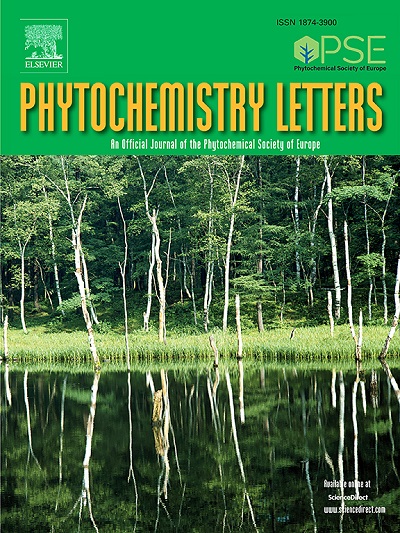船虫共生体Teredinibacter turnerae中一种新的溶鸟氨酸脂质的特性
IF 1.4
4区 生物学
Q4 CHEMISTRY, MEDICINAL
引用次数: 0
摘要
teredinibacterium turnerae将其基因组的很大一部分用于次级代谢物的生物合成。本研究从螺旋螺旋体菌株4401H.S.1B中纯化了新的溶鸟氨酸脂质n -3-羟基油酰鸟氨酸(1)。02-A和4409 W.S.0 A.02-C。该化合物的特点是单羟基化的C18:1脂肪酸通过酰胺键连接到鸟氨酸头基团上。N-3-hydroxyoleoyl鸟氨酸证明弱抗菌活性对浮游葡萄球菌epidermidis(%抑制= 53.5 ±11.8 % 256 µg / mL(620 µM))和弱细胞毒性HK-2正常人肾细胞(IC50 = 11 µM)和HCT116人类大肠癌癌(%细胞生存能力= 47.6 ±8.0 % 100 µM)。1的抗菌和细胞毒活性部分是由其膜破坏活性促进的。n -3-羟基油酰鸟氨酸(1)在对薄荷醇或辣椒素不敏感的10 µg/mL(24 µM)的背根神经节(DRG)神经元中引起Ca2+摄取的间接和不可逆扩增。时间过程研究进一步揭示了T. turnerae 4409 W.S.0 A。02-C受到磷酸盐调控的负调控,可能是通过磷酸依赖的olsB表达调控。本文章由计算机程序翻译,如有差异,请以英文原文为准。
Characterization of a new lyso-ornithine lipid from the shipworm symbiont Teredinibacter turnerae
Teredinibacter turnerae dedicates a significant portion of its genome to secondary metabolite biosynthesis. In this study, we purified the new lyso-ornithine lipid N-3-hydroxyoleoyl ornithine (1) from T. turnerae strains 4401H.S.1B.02-A and 4409 W.S.0 A.02-C. This compound is characterized by a monohydroxylated C18:1 fatty acid attached to an ornithine head group through an amide bond. N-3-hydroxyoleoyl ornithine demonstrated weak antimicrobial activity against planktonic Staphylococcus epidermidis (% inhibition = 53.5 ± 11.8 % at 256 µg/mL (620 µM)) and weak cytotoxicity against HK-2 normal human kidney cells (IC50 = 11 µM) and HCT116 human colorectal carcinoma (% cell viability = 47.6 ± 8.0 % at 100 µM). The antimicrobial and cytotoxic activities of 1 are, in part, facilitated by its membrane-disrupting activity. N-3-hydroxyoleoyl ornithine (1) caused an indirect and irreversible amplification of Ca2+ uptake in dorsal root ganglion (DRG) neurons that are insensitive to either menthol or capsaicin at 10 µg/mL (24 µM). Time course studies further revealed that the production of 1 in T. turnerae 4409 W.S.0 A.02-C is negatively regulated by phosphate control, possibly via a Pho-dependent regulation of olsB expression.
求助全文
通过发布文献求助,成功后即可免费获取论文全文。
去求助
来源期刊

Phytochemistry Letters
生物-生化与分子生物学
CiteScore
3.00
自引率
11.80%
发文量
190
审稿时长
34 days
期刊介绍:
Phytochemistry Letters invites rapid communications on all aspects of natural product research including:
• Structural elucidation of natural products
• Analytical evaluation of herbal medicines
• Clinical efficacy, safety and pharmacovigilance of herbal medicines
• Natural product biosynthesis
• Natural product synthesis and chemical modification
• Natural product metabolism
• Chemical ecology
• Biotechnology
• Bioassay-guided isolation
• Pharmacognosy
• Pharmacology of natural products
• Metabolomics
• Ethnobotany and traditional usage
• Genetics of natural products
Manuscripts that detail the isolation of just one new compound are not substantial enough to be sent out of review and are out of scope. Furthermore, where pharmacology has been performed on one new compound to increase the amount of novel data, the pharmacology must be substantial and/or related to the medicinal use of the producing organism.
 求助内容:
求助内容: 应助结果提醒方式:
应助结果提醒方式:


